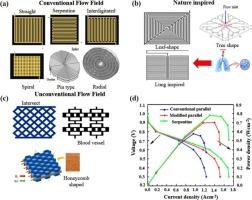Flow field configurations in PEMFCs: Design, Modeling, and performance insights
IF 7.6
Q1 ENERGY & FUELS
引用次数: 0
Abstract
Proton exchange membrane fuel cells (PEMFCs) are a promising clean energy technology due to their high efficiency, zero emissions, and applicability in transport and stationary systems. Despite these advantages, large-scale commercialization is constrained by challenges such as water management, thermal control, material costs, and limited durability. Among PEMFC components, the flow field is critical in ensuring uniform reactant distribution, efficient water and heat removal, and effective current collection. To overcome these limitations, this review systematically examines the evolution of flow field designs, from conventional geometries (serpentine, parallel, interdigitated) to advanced configurations, including biomimetic, baffle-based, porous media, composite, and three-dimensional structures. Key design parameters such as channel shape, curvature, aspect ratio, rib-to-channel ratio, and tapered depth are analyzed for their impact on performance metrics, including power density, gas diffusion, and water evacuation. The review further addresses recent advances in bipolar plate materials and fabrication methods, such as metallic, polymeric composite, and graphite structures. It highlights the role of computational fluid dynamics (CFD), AI-assisted design, and multi-objective optimization in guiding performance improvements. By integrating experimental insights, simulation-based optimization, and emerging design strategies, this review provides a holistic framework to guide the development of high-performance, durable, and cost-effective PEMFC systems.

pemfc中的流场配置:设计、建模和性能洞察
质子交换膜燃料电池(pemfc)由于其高效、零排放以及在运输和固定系统中的适用性,是一种很有前途的清洁能源技术。尽管有这些优势,但大规模商业化受到诸如水管理、热控制、材料成本和有限耐用性等挑战的限制。在PEMFC组件中,流场对于确保反应物均匀分布、高效的水和热去除以及有效的电流收集至关重要。为了克服这些限制,本文系统地研究了流场设计的演变,从传统的几何形状(蛇形、平行、交叉)到先进的结构,包括仿生、挡板、多孔介质、复合结构和三维结构。分析了关键设计参数,如通道形状、曲率、纵横比、肋与通道比和锥形深度对性能指标的影响,包括功率密度、气体扩散和水排出。本文进一步介绍了双极板材料和制造方法的最新进展,如金属、聚合物复合材料和石墨结构。它强调了计算流体动力学(CFD)、人工智能辅助设计和多目标优化在指导性能改进中的作用。通过整合实验见解、基于仿真的优化和新兴设计策略,本综述提供了一个整体框架,以指导高性能、耐用和经济高效的PEMFC系统的开发。
本文章由计算机程序翻译,如有差异,请以英文原文为准。
求助全文
约1分钟内获得全文
求助全文
来源期刊

Energy Conversion and Management-X
Multiple-
CiteScore
8.80
自引率
3.20%
发文量
180
审稿时长
58 days
期刊介绍:
Energy Conversion and Management: X is the open access extension of the reputable journal Energy Conversion and Management, serving as a platform for interdisciplinary research on a wide array of critical energy subjects. The journal is dedicated to publishing original contributions and in-depth technical review articles that present groundbreaking research on topics spanning energy generation, utilization, conversion, storage, transmission, conservation, management, and sustainability.
The scope of Energy Conversion and Management: X encompasses various forms of energy, including mechanical, thermal, nuclear, chemical, electromagnetic, magnetic, and electric energy. It addresses all known energy resources, highlighting both conventional sources like fossil fuels and nuclear power, as well as renewable resources such as solar, biomass, hydro, wind, geothermal, and ocean energy.
 求助内容:
求助内容: 应助结果提醒方式:
应助结果提醒方式:


